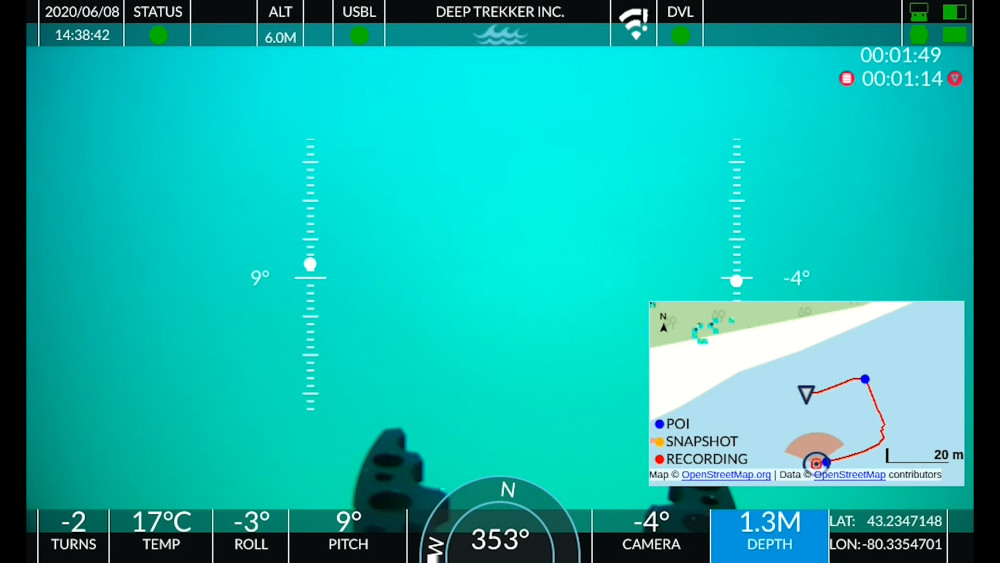Home › Forums › ROV › ROV Technical Discussions › Umbilical sheave diameter
- This topic has 9 replies, 8 voices, and was last updated 17 years, 4 months ago by
GraemeRSU.
-
AuthorPosts
-
July 17, 2007 at 9:20 pm #872
Rons_ROV_Links
ParticipantThe ROV-system I’m working with at the moment has a Nexans umbilical with a minimum bend radius of 1000mm. The sheave we’re using has a diameter of 1050mm, measured in the groove, which is just 5cm bigger than the minimum bend radius.
The umbilical which is 5 years old is showing cracks in the outer plastic layer.I was wondering if there is some kind of golden rule that says: the diameter of the should x times the minimum bend radius of the umbilical ?
Does anybody have any positive (except that they’re cheap) or negative experience with Nexans umbilicals?
July 17, 2007 at 9:41 pm #12907Savante
ParticipantI think there is a DEFSTAN somewhere that states the minimum bend radius in terms of lifetime and electrical/optical losses, but a good reference is ANSI/TIA/EIA-568B.3 – this one applies to optical fibres.
As a rule of thumb….
minimum bend radius of cable = 20x cable diameter(short term)
= 15x cable diameter (long term)So long as you are above the minimum bend radius, it should normally be ok – take factor of 20 as safer.
The other thing is isn’t your current bend radius = 525mm (if your sheave wheel has diameter of 1050mm?). Hence aren’t you using your tether well beneath the rated bend radius?
July 17, 2007 at 11:29 pm #12908centurion
ParticipantHmmmm………….this will throw a spanner in a lot of peoples works.
I’ve seen quite a few systems where diameter and radius are confused.
July 17, 2007 at 11:52 pm #12909TheBaron
Participant😳 Hmmmmm……I have to fess-up on that count! I had a nylon sheave wheel manufactured locally using the bend radius dimension as the diameter. Luckily, I was able to blag that it was intended as a sheave wheel for TS dips, survey sh1te, etc., and I ordered another one for the ROV. 😳
July 18, 2007 at 7:26 am #12910Andy Shiers
Participant😆
And I thought you woz just being proffesional like 😀July 18, 2007 at 2:33 pm #12911Ray Shields
ParticipantThe other thing people forget about is the load rating of the sheave block. I have heard people derating a sheave block too much because of confisuions over how much load it sees depending on the angle of the umbilical.
July 18, 2007 at 4:19 pm #12912Scott Beveridge
ParticipantThe other thing people forget about is the load rating of the sheave block. I have heard people derating a sheave block too much because of confisuions over how much load it sees depending on the angle of the umbilical.
Yeah Ray,
There was a lot that didn’t do the PM and the main attachment clevis pin wore out and the whole sheave assy fell on top of the vehicle (at depth)!!! Ring any bells???
July 23, 2007 at 8:22 pm #12913Rons_ROV_Links
ParticipantThe ‘minimum bend radius’ doesn’t have anything to do with sheaves but with the minimum diameter of winch drums and cable reels.
The sheave diameter should be at least 40 times bigger than the diameter of the umbilical.
The bigger the diameter of the sheave the less pressure per surface unit and thus less stress for the umbilical. A bigger sheave will also extend the lifetime of an umbilical due to less wear.Some usefull documents can be found here:
http://www.rochestercables.com/pdfs/Cable%20Handling.pdf
http://www.unols.org/publications/winch_wire_handbook__3rd_ed/02_oceanographic_em_cables.pdf
http://www.interoceansystems.com/winch_article.htmor use Google and search for: umbilical sheave diameter
July 24, 2007 at 9:52 am #12914Savante
ParticipantI thought minimum bend radius was to do with cable routing in general- so it’d be important in any circumstance or any object the cable was wrapped over/around/under/in, etc. Even more so if it is under tension?
As far as I can make out, the figure for 20 applies to electrooptical fibres, but this was for routing in aircraft, ships and buildings. It may very well be a lot larger for composite cables with "contra – heelically" wound stuff.
Thanks for the references – the second one is excellent.
August 2, 2007 at 12:52 pm #12915GraemeRSU
ParticipantThe ‘minimum bend radius’ doesn’t have anything to do with sheaves but with the minimum diameter of winch drums and cable reels.
The Recommended minimum Bend radius quoted for an Umbilical or tether does have a direct relationship with Sheave size. It apply’s to all parts of the load path.
You also have to be careful that you are using the correct value since some manufacturers quote a static & dynamic value. For operational service the dynamic one applies.
If the radius of your sheave equals the manufacturers recommended value then you should get approximately the expected service life quoted by the manufacturer. If it is greater than the manufacturers value it will extend the service life.
If the bend radius is reduced then this will shorten the service life of the umbilical.
By going to almost half the recommended bend radius on your sheave you will need to expect premature failure (i.e. fibres failing etc) of the umbilical to occur since you will be working it a lot harder than is recommended by the Manufacturer.
Are you sure your umbilical has a minimum bend radius of 1000mm? since if you look at a Nexans NSS8 spec (Workclass ROV umbilical) it only has a minimum bend radius of 750mm, although it is quoted as the diameter which equals 1500mm on their spec.
If the figure you have quoted is actually the minimum bend diameter instead of radius then your sheave is the correct size for your umbilical. I would strongly recommend you double check your umbilical spec before looking at another sheave.
-
AuthorPosts
- You must be logged in to reply to this topic.



